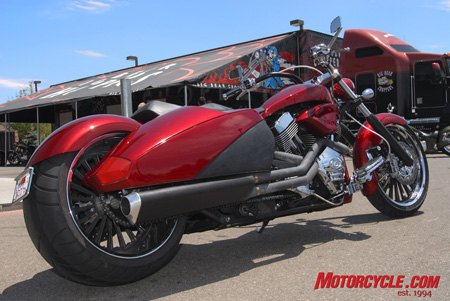Big Bear Choppers and the State of the Production Custom Industry - Motorcycle.com
Bucking the trend of playing it safe when the going gets tough, Big Bear Choppers moves full-force into the future. Not willing to wait around and see what happens to the American V-Twin motorcycle market in the coming years, BBC is taking matters in its own hands with a goal of putting more high-quality custom motorcycles in the hands of its current and future customers.
Blasting out of the gates for 2008, BBC has upped the ante with two brand-new, non-traditional motorcycles (in addition to its current 13 offerings), the G.T.X, and the Paradox. Both bikes are offered with multiple engine choices including S&S Cycle’s revolutionary powerplant, the X-Wedge, and a host of styling and performance items not found elsewhere.
Finding itself in a marketplace showing definite signs of a downturn, owners Kevin and Mona Alsop have moved forward with predictions of higher production numbers, new models, cutting-edge engines, and an increased dealer network.
Not long ago we had an opportunity to spend some time with Kevin and Mona, as we attended BBC’s first-ever dealer summit last summer at the company’s headquarters in Big Bear Lake, CA. BBC has been a player in the production custom/kit-bike market since 1998. Starting off as one of the first companies to supply truly custom motorcycle kit bikes to the industry, BBC has in recent years severely sharpened its focus, trending more toward the production custom class of assembled motorcycles, and less in the direction of kit bikes — what BBC refers to as unassembled motorcycles. These days 85% of what BBC sells are completely assembled custom motorcycles sold through their national dealer network.
BBC’s Dealer Summit was an opportunity for BBC’s dealers, partners, and the press alike to get an up-close look at how the motorcycle manufacturer operates, as well as a glimpse of their future plans. Nothing was off limits; they opened their doors for all to see.
The other day we sat down with Kevin Alsop and a list of questions, and listened intently as he shed some light on BBC’s road map to the future. We began the discussion by asking Alsop for his description of BBC and the products they produce. He responded by telling us “BBC is a micro OE (as in Original Equipment manufacturer), which produces a small volume of production vehicles that have the most aggressive designs available in the market place today.”
Considering Alsop immediately compared BBC’s products to the rest of the industry, we were eager to get his views on the American V-Twin industry as a whole. Since many in the industry have a less than optimistic view of its future, we wondered where Kevin weighed in on the current state of the domestic motorcycle industry. “It’s as strong as it’s ever been," he fired back without missing a beat.
Motorcycle.com reminded Alsop of the lowered production numbers coming out of companies like Harley-Davidson and asked if he still felt as strongly. “Yes, it’s as strong as it’s ever been because it’s still kicking everyone’s ass to the max. Let’s face it, who else is building 300,000 plus units a year? Nobody! Honda’s not doing it, Kawasaki’s not doing that… not in the V-Twin American cruiser market, hell no. The Japanese companies are not competing against the American V-Twins."
Upon arriving at the company’s facility we immediately witnessed the quality BBC builds into its motorcycles that awaited us.
Upon arriving at the company’s facility we immediately witnessed the quality BBC builds into its motorcycles that awaited us. BBC has strived to ensure customer satisfaction since its inception in 1998. One of Kevin and Mona’s prime goals was to give the customer a high-quality product, which would in the long run lead to higher customer satisfaction and increased sales. Since quality is affected by a wide variety of factors, we asked Alsop what he sees as some of the biggest challenges standing in the way of BBC attaining those higher production goals.
“Number one is the economy – spare, disposal money. And the second thing will be the health of the dealer world overall. How many of them will be left in 2009? I think we (BBC) are going to do just fine. Let’s say Harley really took a shit and halved, they’re still selling 150,000 units amongst 600 dealers, and those dealers will be really hungry for business." This scenario is something that Alsop sees as a good opportunity for the company.
When it came to dealer training, he went on to say “we don’t charge our dealers for tech training. We train them for free, they come here for a week, and we actually put them on the line while they each assemble a complete vehicle. This is in addition to verbal, dyno, and diagnostic training. The difference we see is night and day (regarding issues) when comparing a dealer before and after their techs have received training. We have already trained 20 dealers, with 20 more to go, then we will them bring back and do full-on fuel-injection classes with them in the dyno room and show them how to diagnose fuel-injection problems.”
Alsop continued, “When the technician really knows how the product works, the concept behind it, and is not fearful of the product, then they buy into the product. When they are working on someone’s bike, servicing the vehicle, or it has a warranty issue and they fix it, they talk to the customer and they’re our biggest salesmen. That’s why Harley trains their techs – they need their techs to buy into their products. We are growing our dealer network under the most extreme conditions, which is really good.”
In the current climate with buyers snapping up touring machines, BBC decided it was time to push the envelope of the touring market. They did not enter this segment of the marketplace based on a trend that might be over before they got a new bike to market. Alsop also realized he could not just throw bags and a windshield on an existing model and call it a touring machine, as his customers would expect more. For the bike to command respect, it would need to be first and foremost comfortable in all-day one-up and two-up scenarios, have the ability to easily carry gear, exhibit top-notch performance and have the styling one would expect from BBC.
Alsop admits the G.T.X is not a bike for all touring riders, but more a machine designed for riders who appreciate the engineering, performance and design that have gone into it, and have the money to afford it. The Pro-Street style G.T.X. is not cheap: depending on your choice of powerplant, you can plunk down $35,900.
Understanding the limitations of many touring machines, one of Alsop’s main concerns was keeping the mass low and centralized, not just the weight of the bike, but the rider, passenger, and gear. The frame dimensions make this a very do-able proposition. Once seated on the bike, the passenger uniquely sits in front of the 300mm rear tire. This along with the rider position being shifted somewhat forward and a 2.0-gallon auxiliary fuel tank (plus a three-gallon standard tank) mounted below the seat all add to the handling characteristics of the bike. Is this a canyon carver in the true sense of the word? Certainly not, but when you consider the massive rubber, 36-degree neck coupled to 7-degree triple trees up front, the G.T.X. is very respectable.
BBC outfits the bike with the new powerplant from S&S Cycle weighing in at 114-inches. The proprietary fuel-injected motor is a torque monster, and a quick twist of the throttle yields gobs of low-end torque. The strong, steady acceleration accompanied by the deep throaty notes coming from the 2-into-1 exhaust are a joy to the senses. If you dig the G.T.X. but are a bit more of a traditionalist, BBC can outfit the bike with an Evo-style powerplant if you prefer. Due to all the dealers and other members of the press wanting to check out the new models, we only had a chance to take a short spin on each one. Our ride was nowhere near what we would need to give you specifics on how the bike performed. What we can tell you, though, is we can’t wait to get a hold of both of these bikes for some real seat time.
Front to back, the bike’s lines are stunning. Using a combination of close tight-fitting fenders, a sculpted downtube cover and molded oil tank, the bike balances the look of hot-rod styling with a smooth, clean futuristic look. The Paradox gets its name from the fact that such a beautiful bike can be so comfortable while at the same time exhibiting top-notch performance.
From what we have seen it looks like Kevin and Mona have done their homework diligently, studied the history and trends of the American V-Twin market, and taken note of where others have faltered in the past. If things work out the way the pair believes they will, you’ll be seeing a lot more of BBC’s bikes around for a long time to come.
Related Reading:
2008 Victory Models
Harley's Reduced '07 shipments Cause For Alarm?
H-D takes third-quarter hit
More by Steve Bohn


































Comments
Join the conversation